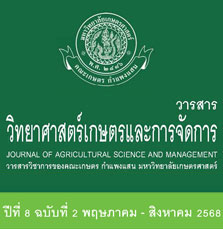Effects of Plant Density on Growth, Yield and Seed Quality of Cowpea (Vigna unguiculata L. Walp.)
Keywords:
population density, seed yield, lateritic soil, cowpeaAbstract
This research aimed to investigate the effect of plant densities on growth, yield and seed quality of cowpea cultivated in field condition under lateritic soil. The experiment was conducted at Faculty of Natural Resources and Agro-Industry, Kasetsart University Chalermphrakiat Sakonnakhon Province Campus, during August 2018 to March 2019. Randomized Complete Block Design (RCBD) with 4 replications was used as an experimental design. Treatments consisted of 3 plants densities (number of plants per hill): 1 plant per hill (4,800 plants per rai), 2 plants per hill (9,600 plants per rai) and 3 plants per hill (14,400 plants per rai), plant spacing at 75x50 cm. The results indicated that plant density had not significant effect on plant height of cowpea. However, statistically significant different (P<0.05) was found in leaf number per plant at 5 weeks after planting, which the planting rate of 1 plant per hill gave the highest average leave number (7.0 leave per plant). Planting rate at 3 plants per hill produced the highest average seed yield (166.7 kg/rai) with significantly different (p<0.05). In term of seed quality (physical and physiological characteristics), significant difference between the treatments was not found (p>0.05). This study concludes that the planting of cowpea at a rate of 3 plants per hill should be used for the cowpea production on lateritic soil, which gave the higher seed yield and seed quality
References
ชื่นจิต แก้วกัญญา, ปนัดดา ประสาทชัย และอมรรัตน์ อุปพงศ์. 2555. ศักยภาพของถั่วเขตร้อนเพื่อเป็นอาหารสัตว์คุณภาพดีและการปรับปรุงบำรุงดินลูกรัง. วารสารวิทยาศาสตร์เกษตร 43 (พิเศษ 2): 585-588.
ชื่นจิต แก้วกัญญา, เครือฟ้า คนหมั่น และรัตติยา สารโภคา. 2565. ผลของอัตราปลูกต่อการเจริญเติบโต ผลผลิตและคุณภาพเมล็ดพันธุ์ของถั่วพร้า. หน้า 151-156 ใน : การประชุมวิชาการนวตกรรมเกษตรและทรัพยากรธรรมชาติ ครั้งที่ 1 มหาวิทยาลัยสงขลานครินทร์ วิทยาเขตหาดใหญ่, สงขลา.
เนตรนภา อินสลุด. 2562. การปลูกพืชบำรุงดิน. โครงการแนวทางการยกระดับการผลิตและการเพิ่มมูลค่าผลผลิตข้าวและกัญชงบนพื้นที่สูง.ภายใต้โครงการบริการวิชาการในลักษณะโครงการ (Project base) เพื่อบูรณาการยุทธศาสตร์. คณะผลิตกรรมการเกษตร มหาวิทยาลัยแม่โจ้, เชียงใหม่. 7 หน้า.
เมธา วรรณพัฒน์. 2533. โภชนศาสตร์สัตว์เคี้ยวเอื้อง. ฟันนี่พับบลิชชิ่ง. กรุงเทพฯ. 473 หน้า.
ศูนย์วิจัยพืชไร่อุบลราชธานี. 2543. ถั่วพุ่ม. โรงพิมพ์ศิริธรรมออฟเซ็ท อุบลฯ, อุบลราชธานี. 39 หน้า.
สุริยนต์ ดีดเหล็ก, มณเทียน แสนดะหมื่น, กัญญารัตน์ สุวรรณ และรัชนี โสภา. 2557. ผลของระยะปลูกและจำนวนต้นต่อหลุมของถั่วเหลืองสายพันธุ์ดีเด่น MHS17 ในแหล่งปลูกจังหวัดแม่ฮ่องสอน. คลังผลงานวิจัย กรมวิชาการเกษตร. (ระบบออนไลน์).แหล่งข้อมูล: http://www.doa.go.th/research/attachment.php?adi=2332 (6 กรกฎาคม 2561).
Agza B., B. Kasa, S. Zewdu, E. Aklilu and F. Alemu. 2012. Animal feed potential and adaptability of some cowpea (Vigna unguiculata) varieties in North West lowlands of Ethiopia. Wudpecker Journal of Agricultural Research 1(11): 478-483.
Association of Official Seed Analysts (AOSA). 1983. Seed Vigor Testing Handbook. 1st Edition, AOSA, East Lasing, 88 p.
Bisikwa, J., R. Kawooya., J.M. Ssebuliba, S.P. Ddungu, M.Biruma, and D.K. Okello. 2014. Effect of plant density on the performance of local and elite cowpea (Vigna unguiculata L. (Walp)) varieties in Eastern Uganda. African Journal of Applied Agricultural Sciences and Technologies (Online) 1 (1): 28-41.
El Naim, A.M. and A..A. Jabereldar. 2010. Effect of plant density and cultivar on growth and yield of cowpea (Vigna unguiculata L. Walp). Australian Journal of Basic and Applied Sciences 4(8): 3148-3152.
Ghiyasi, M., M.R. Zardoshty and A.F. Mogadam. 2008. Effect of osmo priming on germination and seedling growth of corn (Zea mays L.) seeds. Research Journal of Biological Science 3(7): 779-782.
Ginka A. A., D.S. Tsvetelina and M.I. Marin. 2014. Proximate and lipid composition of cowpea (Vigna unguiculata L.) cultivated in Bulgaria. Journal of Food Composition and Analysis 33 (2):146–152.
ISTA. 2017. International Rules for Seed Testing. International Seed Testing Association. Bassesdorf, Switzerland. Available Source : https://www.seedtest.org/en/home.html (February 10, 2019).
Prusiński, J. 2022. Effect of row spacing and plant density on the yield of Faba bean L. under vary differentiated humidity conditions. Journal of Agricultural Science 14 (1): 1-10.
Vujakovic, M., A.M. Jeromela, D. Jovicic, N. Jakovljevic, R. marinkovic, N. jakovljevic and S.M. Stanisic. 2014. Effects of plant density on seed quality and yield of oilseed rape (Brassica napus L.). Journal on Processing and Energy in Agriculture 18(2): 73-76.






